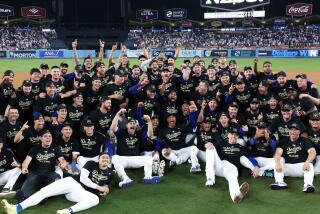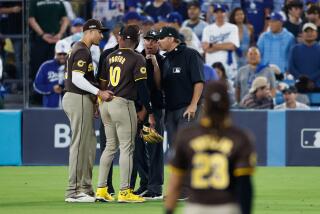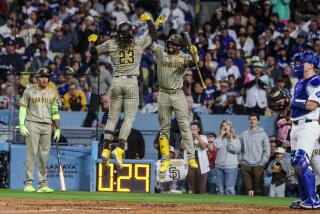Gardner Finds a Home in San Diego : Baseball: After a long stint in the minor leagues, former Estancia and Orange Coast standout is making a name for himself with Padres.
SAN DIEGO — It took nine years and a couple of lucky breaks, but Jeff Gardner is finally free from the shackles that chained him to the minor leagues.
Gardner, a former Estancia High School and Orange Coast College standout, walked into the San Diego Padres’ clubhouse last weekend, and there was his name in the starting lineup, right behind eight-time all-star and leadoff hitter Tony Gwynn, and just in front of 1992 batting champion Gary Sheffield and 1992 home run leader Fred McGriff.
It wasn’t as if Gardner had to pinch himself. The 29-year-old second baseman is entering his third full month in the major leagues and has started two-thirds of the Padres’ games, so the novelty all has worn off.
But every time he sees his name over a big league locker-room cubicle, or sees a check with those big numbers, or goes on the road and gets that big per diem--it’s $60 in the major leagues, compared to $18 in triple-A--Gardner realizes how fortunate he is and how long and hard he worked to get here.
“It has been great--I love it here,” said Gardner, a left-handed hitter who is batting .285 with 11 doubles while platooning with Tim Teufel at second base. “We were able to rent a house instead of an apartment, and the meal money is real nice. I don’t have to bring an extra $100 to $200 on road trips to get by.
“I’m close to home, my family comes down to watch me play, and there are a great bunch of guys on the team. It’s unfortunate we’re not playing as well as we’d like, but it’s a fun place to play.”
Gardner couldn’t have picked a better place to play. In fact, when Gardner was working out at a Costa Mesa health club in the winter of 1991, a friend asked: “If you could play for any organization in baseball, who would you play for?”
Gardner was quick with his reply: “San Diego.”
That night, Dec. 11, 1991, Gardner was traded from the New York Mets to the Padres for pitcher Steve Rosenberg.
At the time, Gardner just wanted out of the infielder-heavy Mets’ organization, which he felt had pigeon-holed him into a minor league role. He was tired of moving his family, which includes his wife and two daughters, back and forth between Norfolk, Va., home of the triple-A Tidewater Tides, and Orange County.
San Diego seemed a logical choice. If Gardner could crack the major league roster, he would be close to home without facing the distractions he might have playing in Anaheim or Los Angeles. If he remained in triple-A, at least he’d be in Las Vegas, only a few hours from home.
Then, after going years in the Mets’ organization without catching a break, everything started falling in place for Gardner at a time when the Padre organization seemed to be falling apart.
Gardner, buoyed by a lower-body strength and conditioning program, had his best professional season in 1992, batting .335 with 30 doubles, five triples and 51 runs batted in for Las Vegas Stars Manager Jim Riggleman.
Gardner was called up to the Padres on Aug. 31, and a few weeks later, Riggleman replaced the fired Greg Riddoch as San Diego manager.
Finally, an ally in a major league manager’s office. Gardner knew he’d get a shot at making the Padres in 1993, but it became definite when the organization spent the off-season dumping some $16.5 million in salaries, unloading high-priced free agents such as Benito Santiago and Randy Myers, and trading high-priced shortstop Tony Fernandez to the Mets.
Padre fans, believing the team wasn’t attempting to put the best possible product on the field, fumed all winter.
Gardner celebrated.
“The (Padres’ financial situation) absolutely worked in my favor,” said Gardner, who makes the major league minimum $109,000. “They were trying to get rid of some salaries, and the Fernandez trade opened up a middle infield position. I knew the people here wouldn’t like it, but it gave me an opportunity to play.”
Gardner forgives Padre fans for not welcoming him with open arms. While he hasn’t noticed any ill feelings directed specifically at him, Gardner has sensed the fans’ frustrations when the team, mired in sixth place in the National League West, goes through losing streaks.
“It’s kind of calmed down--only when we’re playing bad do you sense that fans think this team is ridiculous,” Gardner said. “It doesn’t bother me, and I try not to worry about it. I’m just a first-year guy trying to do the job.
“People sometimes don’t understand there are a lot of good minor leaguers who can play at this level, guys like J.T. Snow and Tim Salmon, but teams have to take a chance and give them a shot. Hopefully some day the fans can look back and say this year wasn’t good, but at least it gave Jeff Gardner an opportunity to play, and look what he’s done for us.”
And just what has Gardner been doing for the Padres? Well, nothing spectacular, but nothing shoddy, either. Gardner has provided a steady bat and glove and has impressed teammates and coaches with his ability to turn the double play, his forte since his sophomore year at Orange Coast.
“I was already high on him, and he has exceeded everything I expected,” Riggleman said. “He has been solid in the infield, he turns the double play very well, and he’s a leader on the field. These were the same things he did last year in Las Vegas.”
Gardner won’t overwhelm you with his baseball skills, but his ability tends to grow on you.
“He’s not the fastest guy in the world, he doesn’t have the world’s quickest bat or greatest range, but he comes to play every day,” Gwynn said. “He’s not a flashy type. He gets down and dirty, and he’ll ping, pang, pong you to death. You have to see him every day to appreciate the things he brings to the table.”
Gardner needed a booster seat to get to the table, though. The 5-foot-11, 175-pounder made steady progress through the Mets’ farm system, rising from Class A in 1985 to triple A in 1989, but he seemed to hit the wall in triple A.
His triple-A numbers were decent--.279 in 1989, .270 in 1990 and .292 in 1991--and he was a highly regarded defensive player, but he logged only 13 games with the Mets during a September, 1991, call-up before being traded.
“It was a situation where they labeled me as a triple-A player, and rightfully so, a lot of times,” Gardner said. “It wasn’t until 1991, when I made some offensive strides and started driving the ball more, that I felt I could hit at the next level. Had I done that earlier, maybe they wouldn’t have labeled me. But at the same time, I felt they could have stayed with me.”
Gardner is confident that, now that he has finally reached the big leagues, he will stay for a few years. Though you won’t find him on the all-star ballot, Gardner thinks he’s proved to fans and management that he belongs here, that he’s more than just a bargain-basement second baseman or beneficiary of the Padres’ cost-cutting moves.
“There’s no question he can play in the big leagues,” Gwynn said. “After all the moves last winter, the fans were asking, ‘Who are these guys? Jeff Gardner, Craig Shipley, Ricky Gutierrez? But most of the negative stuff was residue from the winter, not for what they’re doing at the park. Gardy is a steady player. He’s good enough to hang here.”
More to Read
Go beyond the scoreboard
Get the latest on L.A.'s teams in the daily Sports Report newsletter.
You may occasionally receive promotional content from the Los Angeles Times.











